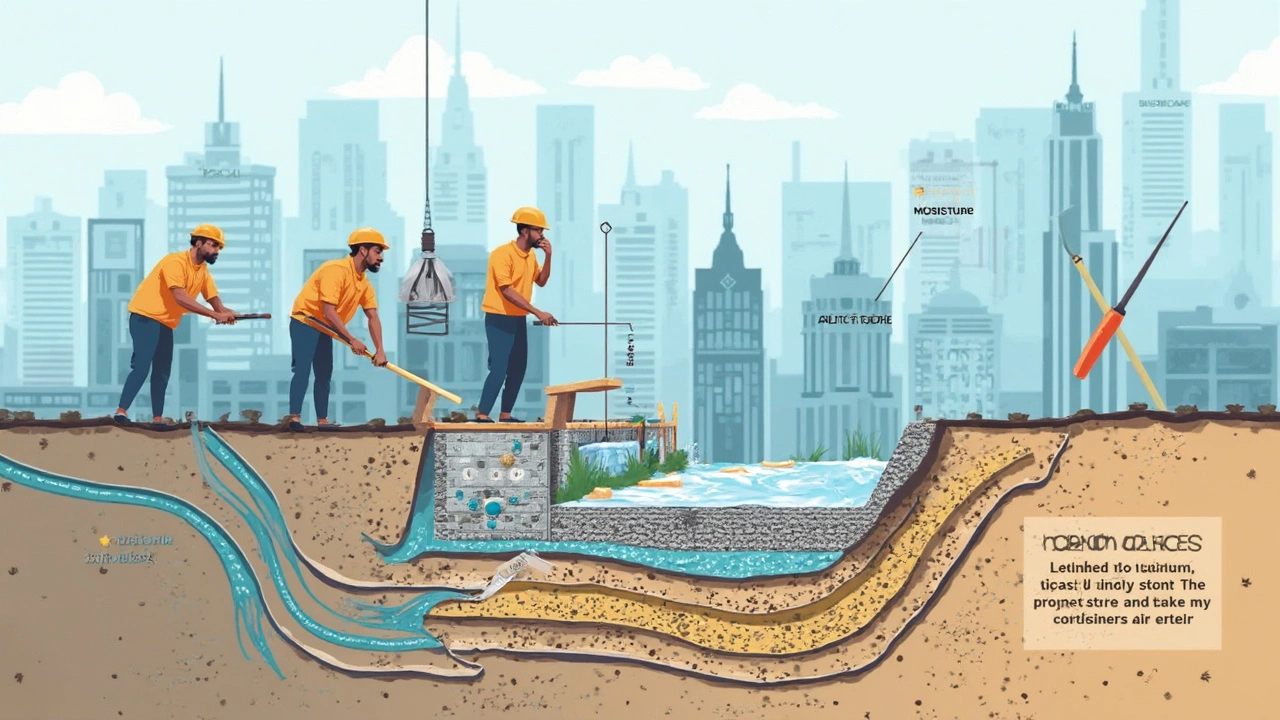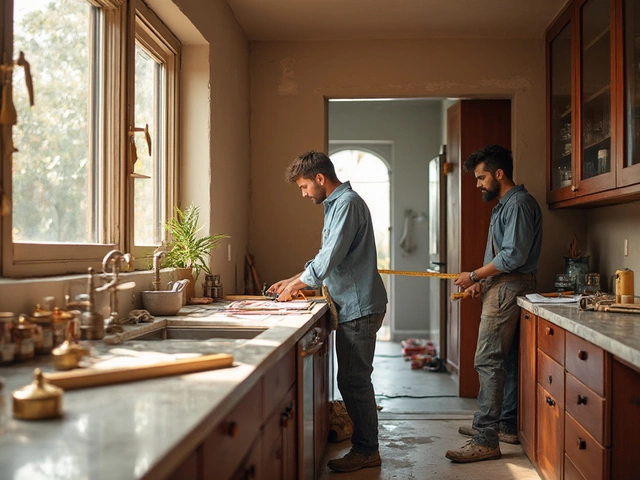Prevent Cracks in New Build Homes: Simple Steps that Work
Seeing cracks in a brand-new home? It’s surprisingly common, but you don’t just have to cross your fingers and hope for the best. A little know-how goes a long way—seriously, the choices made during the building process make all the difference between a smooth wall and a spider-webbed mess six months after move-in.
Start by asking your builder what materials they’re using—and don’t be shy about it. Materials expand and contract when temps go up or down, and not all bricks or plaster are created equal. Cheap stuff tends to crack more, simple as that.
One fact a lot of folks miss: most cracks are caused by moisture problems. If your new place doesn’t have proper drainage or if the builders rushed the concrete, you’re practically inviting trouble. So, before the walls go up, double-check that your site slopes away from the house and make sure nobody’s cutting corners when it comes to letting materials dry out.
- Why New Builds Crack
- Right Materials from Day One
- Keeping Moisture in Check
- Getting the Foundations Right
- Spot-Checks and Maintenance Tips
Why New Builds Crack
It always feels strange to see a crack in a house that’s barely finished. But you’re not alone if this has happened. In fact, the first year after construction is when most cracks show up—often because the whole building is settling and drying out at the same time.
Here’s what really causes these cracks:
- New build homes deal with a lot of movement at the start. Concrete, mortar, and plaster shrink as they lose moisture, which could leave little cracks on your ceiling or walls.
- Foundations need time to adjust too. The soil below your home sometimes shifts (especially if it’s clay or you’re in a spot with big weather swings) and that can tug at your new walls.
- Builders are on tough deadlines. Sometimes, they rush jobs, pouring concrete or plaster when it’s too cold, or not letting materials dry out fully. Fast-tracks like this pretty much guarantee hairline cracks later on.
- Temperature swings matter. Houses built in summer but finished in winter (or vice versa) go through real stress as they heat up and cool down. The constant expansion and contraction will test any joint or seam in the building.
| Cause | Typical Timing | How Common? |
|---|---|---|
| Shrinkage (drying out) | First 3-12 months | Very common |
| Foundation movement | Within 2 years | Depends on soil and drainage |
| Temperature swings | Seasonal changes | Happens in most climates |
| Rushed materials | Post-handover | Common in high-speed builds |
If you spot cracks early, it doesn’t always mean bad building. Small gaps (less than 2mm wide) are almost always cosmetic. But if you see them get wider, stretch over door frames, or keep growing, it’s time to get someone in for a look. Knowing why cracks happen puts you one step ahead before you panic—or before anyone moves in.
Right Materials from Day One
Nobody wants to fork out their savings for a "new build" and then end up staring at cracks in the walls within the first year. A massive chunk of these drama moments can be pinned on picking the wrong stuff when building. Using the right materials from the start means fewer headaches and trips to the hardware store down the road.
Concrete, bricks, mortar, plaster—each plays a role. For example, high-quality cement with fewer impurities has way less chance of shrinking or crumbling. Modern blocks like autoclaved aerated concrete (AAC) are lighter and swell less with weather shifts. Good builders know: you get what you pay for in building materials.
“Using cheaper, low-grade materials to cut costs in a new build is a common cause of early cracking,” says Mark Spence, head of technical support at the Federation of Master Builders.
Don’t be afraid to ask for details. Here’s what you want from your builder before they mix or lay a thing:
- Are they using reinforced concrete? It’s tougher against shrinkage.
- Is the timber kiln-dried? Damp wood is a crack magnet.
- Are metal lintels or supports properly treated to prevent rust and movement?
- Is the plaster “slow-dry” or rushed to save time?
Here’s a quick look how common wall materials stack up for crack prevention:
| Material | Crack Resistance | Notes |
|---|---|---|
| Reinforced Concrete | High | More expensive but stronger and longer-lasting |
| AAC Blocks | Medium-High | Lightweight, less likely to shrink |
| Traditional Bricks | Medium | Stable but watch for dodgy lots |
| Cheap Plaster | Low | Dries fast, cracks more |
So next time somebody tries talking you into a cheaper option, just remember: a few extra bucks now saves you fixing cracks later. Always ask for the specs—and if it sounds too cheap to be true, it probably is.

Keeping Moisture in Check
If you want to prevent cracks in your new build, way more rides on moisture than most builders admit. Water is the silent troublemaker—too much or too little screws up almost every material, from concrete to drywall. Think about this: nearly 60% of common house cracks trace back to water finding its way where it shouldn’t.
Damp ground, poor drainage, and leaks are the top culprits. Even if a wall looks perfect when you get your keys, hidden moisture can take months to show its ugly side. Keeping water out from the start is like insurance against future hassle. The National House Building Council puts it straight:
"Proper control of moisture isn’t just a best practice—it's essential for the long-term stability of a new home. Ignoring drainage and drying times leads to cracks, plain and simple."
Here’s what actually works to dodge these headaches:
- Drainage matters. Gutters, downpipes, and French drains around your place move water away fast. Don’t let any water pool near your foundation—this is crack city waiting to happen.
- Let concrete and plaster cure. Don’t rush builders to finish. Concrete slabs and plaster walls need time (sometimes weeks) to dry properly, or cracks will pop up before you even hang your first picture.
- Check for hidden leaks in pipes and HVAC units once you move in. Even small drips over weeks can mess with your walls and floors.
- Use vapor barriers. Good builders use special sheets in walls and under floors to keep ground moisture out. Ask about this—don’t assume it’s always done right.
- Keep airflow steady. Run those extractor fans and keep windows cracked open in the early months. Fresh air helps materials dry out naturally.
Bottom line: moisture control isn’t flashy, but it’s what keeps your house looking new. Make sure your builder actually cares about it—and keep checking even after you move in.
Getting the Foundations Right
If you mess up the foundation, nothing else matters. Cracks in new build homes almost always tie back to problems down below—literally. The ground your home sits on has everything to do with how solid things will stay over the years.
First off, soil type matters more than most people think. Clay-heavy soil expands and shrinks depending on moisture, and that movement puts big stress on your floors and walls. Sandy soils drain well but need proper compacting, or your house could slowly settle unevenly. One study from the NHBC (National House-Building Council) showed that about 60% of new build structural claims are related to unstable ground, so it's not rare.
- Always get a soil survey before building. It tells you what kind of foundation suits your lot.
- Ask for properly compacted soil—rushing this step leads to subsidence later.
- Use concrete of the right mix and strength for your area. Cold weather? You’ll want a special mix that can handle freezing and thawing cycles.
- Drainage around your foundation must slope away from the house. Otherwise, water can pool and make the soil swell up or wash out under your slab.
Here's a quick comparison of common foundation issues and how to dodge them:
| Problem | What Causes It | How to Avoid |
|---|---|---|
| Settlement cracks | Poor or uneven compacting | Slow, thorough soil prep |
| Heave cracks | Clay soil swelling after heavy rain | Good soil drainage, soil survey |
| Shrinkage cracks | Rushed concrete pouring and drying | Let concrete cure fully, don’t rush the build |
If your builder skips these basics, you’ll spot cracks as soon as the first winter rolls in. Don’t be afraid to speak up and ask for details about the process. Getting these things right from the start saves a lot of hassle and cash later on. Remember, the quality of your new build depends on what happens before you ever see the walls go up.

Spot-Checks and Maintenance Tips
If you think once the paint dries you’re off the hook, think again. Keeping cracks away in your new build means regular spot-checks, especially in the first few years while everything settles.
So, what do you need to focus on? Here’s a straightforward checklist that actually works:
- Walk around inside and outside: Look for hairline cracks, bulges, or spots where materials meet—these are usually the first to show trouble.
- Pay attention to doors and windows: If they start sticking or won’t close right, it’s often a hint that there’s movement behind the scenes.
- Check ceilings and corners: These weak spots love to show early warning signs. See any splits where walls and ceilings meet? Don’t ignore them.
- Keep an eye on paint and plaster: Bubbling, peeling, or uneven spots can point to hidden leaks or poor materials.
Timing also matters. Most structural cracks pop up in the first 18 to 24 months, according to a survey by the NHBC (the UK’s main new build warranty provider), which found that around 60% of new homeowners reported minor cracking in the first two years.
| When to Check | What to Look For |
|---|---|
| Day 1-60 | Surface cracks, settling gaps around frames |
| Month 3-12 | Humidity-related warping or expansion cracks |
| Year 1-2 | Foundation cracks, deep wall fissures, drainage issues outside |
Don’t just spot a crack and shrug. Take clear photos, jot down the date, and track if things get worse. Most new builds come with a warranty—usually ten years for structural stuff—so report issues right away. Small fixes like reapplying sealants, making sure gutters are clear, and patching hairline cracks with proper filler go a long way to avoid bigger headaches.







Comments